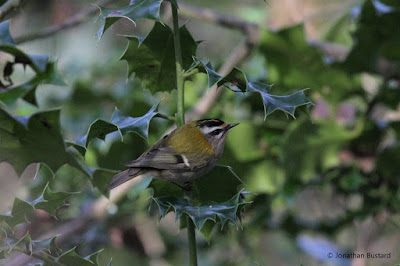Also feeding along the beach at the Point was this turnstone. There was no sign of the two snow buntings seen a couple of days earlier on the Monday by Angela Buckley. Other birds noted were a red-throated diver in the river Colne, eight red-breasted mergansers upriver and one great crested grebe flying past. A grey seal was feeding on a fish close to the Point.
For a while on Wednesday there was little to see in the mouth of the Colne because of a thick haar that rolled in over the sea.
A buck muntjac deer was spotted on Wednesday as I drove past the Manwood Grove near the top end of Shop Lane. After a bit of browsing it disappeared into the wood.
It had been a cold overnight Sunday into Monday morning with this patch of frozen water still sitting on the Strood channel by late morning on Monday 25th. Birds of note included three buzzards, marsh harrier, 25 avocets, while in the fields were 300 brent geese, 100 golden plover, two Mediterranean gulls and two stonechats.
A kestrel was photographed near Feldy View by Andy Field on Friday 22nd.
A peregrine was seen flying over the Feldy seawall on the mainland as it headed over to Copt Hall. Two buzzards and a couple of sparrowhawks were noted along the Strood seawall. A kingfisher perched on the seawall sluice and the bearded tit was seen in the reeds by Andy Field. Also of interest were a stonechat, rock pipit, six linnets as well as seven avocets, 80+ shelduck, 100 teal and a little egret.
A red kite was seen by Kate Entwistle flying over her Empress Drive house on Friday. The firecrest was seen feeding in the holly bushes in Reymead Wood on Friday afternoon, also three song thrushes heard singing and a sparrowhawk passed over.
A barn owl flew low over Shop Lane on Friday, almost crashing into the car windscreen of Michael Thorley as he drove along late afternoon. The Cetti's warbler was heard calling from the Maydays dyke by Martin Cock on Friday.
On Thursday 21st, two peregrines were seen together briefly close to the Strood causeway before heading off in opposite directions. A marsh harrier flew over Ray Island while along the channel were 11 avocets, 106 shelduck, 48 curlew and 300 golden plover, also two stonechats beside the seawall. The large flock of 1000 brent geese was feeding on the Peldon side.
The firecrest was seen on Thursday by Michael Thorley, it showed well feeding in the hollies in the middle of Reymead Wood.
A grey squirrel was pictured on trail-camera in the Seaview Avenue garden of Duncan Philpott on Saturday 23rd. Measures had been started the day before to try and catch this individual.















































